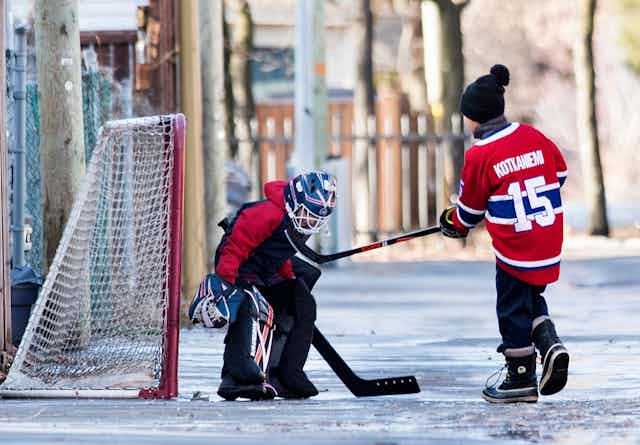Given the climate in much of Canada, cold, wet or snowy conditions are inescapable for many months of the year. And like it or not, weather and seasonality are a barrier to Canadian children engaging in physical activity. Consequently, we need to find a way to help children (as well as parents and educators) embrace the outdoors and stay active all year round.
This is particularly important as kids are more active outdoors than indoor. Since children’s activity levels vary with the seasons, getting kids outside year-round is important for meeting movement guidelines.
Physical activity in cold, wet months
Snow and cold temperatures are tied to low levels of physical activity. Parents have identified warmer seasons as more conducive to physical activity for their children and colder seasons as posing greater challenges.
What’s more, children’s social and built environments are not very accommodating of active living in the winter. When temperatures are low, social norms among Canadians encourage staying indoors participating in more sedentary behaviours, like watching movies, streaming shows, playing video games, reading books or doing crafts. Likewise, extremely hot and humid days also have the tendency to drive kids indoors.
Many of the environments in which children spend the majority of their waking hours during the week (schools and childcare) often have strict policies prohibiting outdoor play when temperatures drop below a particular level. Even when kids can get outside, there are many safety regulations these settings must abide by (such as prohibiting some outdoor equipment, splashing in puddles, and making snow hills off limits), which hamper children’s innate desire to move their bodies outdoors.

Fortunately, changing seasons also present unique opportunities to be active, try different activities and improve healthy behaviours. Different settings — including water, ice, and snow — provide opportunities to develop or enhance new skills, like balance, co-ordination, agility, lifting and lowering, running, crawling, throwing and hopping.
How to help kids stay active all year long
Based on current research, there are numerous evidence-informed recommendations that can be drawn upon to help support, encourage, and promote increased activity levels among children.

Keep it fun and positive. Children have different interests and enthusiasms, so it is important to suggest and enable activities that your child will enjoy. This may involve some trial and error: you might make mistakes and you might find different children in your home enjoy different activities.
Stick to a routine. Find the times for activity that work best for your family and stick with them. In certain cases, you may need to get creative and consider new ways to get active if it’s not possible to play outside (heat or cold weather advisories). Also be mindful that it gets dark early during the winter months.
Make it a family affair. Physical activity should be valued by the whole family and maintained as a priority. Getting everyone involved (including the family dog!) provides key opportunities to model healthy behaviours and provide positive behavioural prompts. Bonus: physical activities are a great way to spend time and bond as a family.
Break it up. Kids do not need to accumulate the recommended 60 minutes of daily moderate-to-vigorous physical activity in a single bout. It is OK to break it up and still reap the health benefits. Every little bit helps!
Dress to impress. Wear layers (this will help children regulate their body temperature) made of breathable materials that repel water, and wear gloves, hats and warm boots when frostbite is a risk. From a health and safety perspective, wear reflective gear (to be seen at night), wear sunscreen and sunglasses (UVA/UVB rays are present, and water and snow-covered surfaces reflect the sun), and remember that helmets are as essential for tobogganing, skiing, and skating as they are for cycling, skateboarding, and rollerblading.
Need some ideas to get your kids moving?
There are plenty of options to keep children moving in any season, many of which can be done in groups, with the family, or even solo.
When the opportunity arises to get kids outdoors, consider some of the following activities: play tag, go for walks, rake leaves, swim in a pool or lake, go cycling or wheeling with friends.
In colder weather, build a snowman/snow angel, go tobogganing, have a snowball fight, go skiing (cross-country or downhill), try snowshoeing, go skating, help with snow shovelling, build a snow fort or try snow painting.

And in those instances when it’s not safe to be outdoors, don’t let this deter children from moving their bodies. Either take the fun indoors or just venture outside for a short time — kids need the fresh air for a brain break and to expend energy.
Some indoor activities include: have a dance party, play hide and seek, help with household chores, do yoga, participate in an indoor scavenger hunt or obstacle course. If you don’t have a ton of space indoors, venture to a community recreation centre or sports facility.
Check your local recreation centre for classes and activities, or your YMCA, indoor pool, ice rink or gym. Try ice skating or roller skating, go bowling or take a long walk inside the local mall.
Physical activity is an important part of children’s healthy development — ensuring this need is met in every season is equally important!

